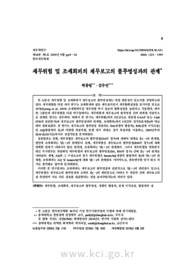

PARTNER
검증된 파트너 제휴사 자료
세무위험 및 조세회피의 재무보고의 불투명성과의 관계 (Tax Risk or Tax Avoidance and its Relation tothe Opacity of Financial Reporting)
46 페이지
최초등록일 2025.05.15
최종저작일
2019.09

-
미리보기
서지정보
· 발행기관 : 한국세무학회
· 수록지 정보 : 세무학연구 / 36권 / 3호 / 9 ~ 54페이지
· 저자명 : 박종일, 김수인
초록
본 논문은 세무위험 및 조세회피가 재무보고의 불투명성과는 어떤 관련성이 있는지를 규명하는데 있다. 세무위험을 다룬 과거 연구는 조세회피와 같은 세무포지션이 세무불확실성을 증가시킬 것으로 보아(Dyreng et al. 2019) 조세회피처럼 세무위험 역시 정보의 불확실성을 높인다고 가정한다. 하지만 그동안의 세무위험을 다룬 연구들에서는 세무위험과 재무보고의 불투명성 간의 관계를 직접적으로 살펴본 연구는 전무하다. 따라서 본 연구는 세무위험(과거 5년간으로 측정된 GAAP 또는 Cash ETR의 표준편차)과 재무보고의 불투명성과의 관계를, 조세회피(과거 5년간의 장기유효세율)와 비교하여 살펴보았다. 본 연구는 재무보고의 불투명성 측정치로 DA(재량적 발생액), RM(실제 이익조정) 및 AQ(발생액의 질)의 다양한 측정치를, 또한 당기 외에도 장기 측정치를 이용하고, 2003년부터 2016년(2017년)까지의 상장기업을 분석하였다.
실증결과는 첫째, 세무위험은 재무보고의 불투명성(DA의 경우)에 대하여 대체로 음(-)의 관계를, 반면에 조세회피는 양(+)의 관계였다. 둘째, 세무위험은 재무보고의 불투명성(RM의 경우)에 대해 명확한 관계가 나타나지 않은 반면에, 조세회피는 양(+)의 관계였다. 그러나 세무위험을 연속변수 대신 지시변수로 측정하면 세무위험과 재무보고의 불투명성(DA, RM의 경우) 간에 음(-)의 관계로 나타났다. 셋째, AQ와 그 구성요소의 경우 세무위험은 InnateAQ(재량적 발생액의 질)와 양(+)의 관계를, 조세회피는 AQ 및 InnateAQ에 대해 양(+)의 관계였다. 마지막으로, 종속변수를 당기 대신 차기로 분석해도 앞서와 일치하였다.
이러한 본 연구결과는 조세회피는 재무보고의 불투명성과 전반적으로 양(+)의 관련성이 있으나, 세무위험은 재무보고의 불투명성과 오히려 음(-)의 관련성으로 나타나 두 측정치 간에 재무보고의 질 측면에서 서로 다른 정보를 내포한다는 것을 보여주었다는데 의의가 있다.영어초록
This study examines whether relation between tax risk/tax avoidance and opacity in financial reporting, through this we investigate tax risk and tax avoidance implications of financial reporting quality. In particular, this paper examine whether tax risk provides examples of how, and in which setting, information attributes about earnings quality, compared to tax avoidance. Prior research mainly focus on that tax avoidance is associated with aggressive financial reporting. For examples, Balakrishnan et al. (2012) and Park et al. (2017) find that firms’ tax aggressiveness is decreasing with financial reporting quality (i.e., accruals quality), whereas Shin et al. (2011), Kim et al. (2013), and Park and Park (2016) find the a negative relation between tax avoidance and discretionary accruals/real earnings management. Thus, there are competing views and mixed evidence on that as firms engage in greater levels of tax avoidance exhibit more or less financial reporting quality. However, what is unknown in the tax literature is whether firms with relatively high tax risk related to financial reporting quality. Therefore, we investigate whether either positive or negative the relation between tax risk and opaque financial reporting is an empirical question, which is a relatively unexplored area of tax research.
In this study, we use nine accounting based measures of opaque financial reports as the dependent variable - we use are:our first proxy for financial reporting opacity is based on firms’ discretionary accruals (hereafter DA), current DA, following Hutton et al. (2009) and Jeon and Park (2017), we use financial reporting opacity (hereafter OPACITY1, OPACITY2, respectively) in year t as the three-year (t-2, t) moving sum of the absolute value of annual DA, and the standard deviation of DA. We use the Dechow et al. (1995) and the Kothari et al. (2005) model to estimate the discretionary accruals. Our second proxy for financial reporting opacity is based on firms’ real earnings management (RM), following RM studies (e.g., Roychowdhury 2006), we consider three types of RM activities, by summing up the three individual measures (i.e., AbCFO, AbPROD, and AbDISE) as well as similar Hutton et al. (2009) and Jeon and Park (2017) methods, we construct two financial reporting opacity (hereafter OPACITY3, OPACITY4, respectively) in year t as the three-year (t-2, t) moving sum of the value of annual RM divided by 3, and the standard deviation of RM. Our third proxy for financial reporting opacity is accruals quality, following Francis et al. (2005), when we disaggregate the AQ into discretionary AQ versus innate AQ component (hereafter AQ, DiscAQ, and InnateAQ, respectively). In our set of tests, we examine the association between opaque financial reporting and tax risk/tax avoidance, as interest variable which we measure using the standard deviation of annual GAAP (Cash) ETRs over the five prior years (e.g., Guenther et al. 2017). Following prior ax avoidance studies (e.g., Dyreng et al. 2008), we calculate GAAP (Cash) ETRs over the period t-4 to t. For our empirical tests, sample firms are collected from the Korea Exchange from 1999 to 2017. We consider 6,880 firm-year observations for sample firm satisfying of the condition for firms with positive pre-tax income and ETR data from 2003 through 2016 (2017 based lag model) to construct two effective tax rate measures.
Our results are as follows. First, after controlling for various firm characteristics and tax avoidance that affect the dependent variable (e.g., opacity in financial reporting), we find a negative and significant relation between tax risk and opacity in financial reporting (i.e., DA, OPACITY1, OPACITY2). In contrast, we find no significant relation between tax risk and opacity in financial reporting (i.e., RM, OPACITY3, OPACITY4). However, tax risk are significantly and positively associated with innate AQ. Whereas, we find no significant association between tax risk and both AQ and discretionary AQ. Second, after controlling for various firm characteristics that affect the dependent variable, we find overall positive and significant relation between tax avoidance and opacity in financial reporting (i.e., DA, OPACITY1, OPACITY2, RM, OPACITY3, OPACITY4, AQ, InnateAQ). Third, when we set an indicator variable equal to 1 for firms with relatively high tax risk instead of continuous variable, we find the negative and significant relation between tax risk and opacity in financial reporting (i.e., DA, OPACITY1, OPACITY2, RM, OPACITY3, OPACITY4), and this relation is more pronounced. Lastly, we also utilize current as well as one-year-ahead dependent variable as measures of opaque financial reporting are similar results. Overall the results indicate that opaque financial reporting is significantly and negatively associated with tax risk. In contrast, the results for multivariate regressions consistently indicate that tax avoidance are significantly and positively associated with the measures of opaque financial reporting. However, where the InnateAQ are largely similar to those tax avoidance and tax risk.
In summary, these results show that the information attributes embedded in tax risk is associated with higher financial reporting quality, whereas tax avoidance is associated with lower financial reporting quality, thus both tax risk and tax avoidance are measures capturing different aspects of earning quality. The prior literature, however, emphasizes the informational properties of tax risk/tax avoidance about uncertain tax-related activities and does not investigate the implications of tax strategy on the overall corporate information quality. Our paper posits a much broader scope for the transparency implications of tax risk/tax avoidance firms, and we encourage future researchers to further explore the boundaries and implications of firms’ tax choices. Also, future research should focus on why tax risk and financial reporting quality are positively related and explore the firm characteristics. Our study is the first to examine the association between tax risk and financial reporting quality, thus contribution to the tax and accounting literatures.참고자료
· 없음태그
-
자주묻는질문의 답변을 확인해 주세요

꼭 알아주세요
-
자료의 정보 및 내용의 진실성에 대하여 해피캠퍼스는 보증하지 않으며, 해당 정보 및 게시물 저작권과 기타 법적 책임은 자료 등록자에게 있습니다.
자료 및 게시물 내용의 불법적 이용, 무단 전재∙배포는 금지되어 있습니다.
저작권침해, 명예훼손 등 분쟁 요소 발견 시 고객센터의 저작권침해 신고센터를 이용해 주시기 바랍니다. -
해피캠퍼스는 구매자와 판매자 모두가 만족하는 서비스가 되도록 노력하고 있으며, 아래의 4가지 자료환불 조건을 꼭 확인해주시기 바랍니다.
파일오류 중복자료 저작권 없음 설명과 실제 내용 불일치 파일의 다운로드가 제대로 되지 않거나 파일형식에 맞는 프로그램으로 정상 작동하지 않는 경우 다른 자료와 70% 이상 내용이 일치하는 경우 (중복임을 확인할 수 있는 근거 필요함) 인터넷의 다른 사이트, 연구기관, 학교, 서적 등의 자료를 도용한 경우 자료의 설명과 실제 자료의 내용이 일치하지 않는 경우
“세무학연구”의 다른 논문도 확인해 보세요!
-
재산세의 시가표준액 및 세액 형평성에 대한 연구-주택과 근린생활시설 간의 비교를 중심으로- 25 페이지
본 연구는 재산세 과세표준을 구성하는 시가표준액의 산정체계가 상이한 주택과 비주거용 부동산을 대상으로 재산세 과세체계의 형평성을 분석하였다. 주택의 시가표준액은 주택공시가격으로써 주거용 건축물과 그 부속토지를 합산하여 산정하고 있지만 비주거용 부동산은 시가표준액을 토지와 건축물로 분리하여 산정하고 있고, 재산세 역시 분리하여 과세하고 있는 실정이다. 이와 .. -
상속세 및 증여세법상 비상장주식의 보충적 평가방법 적용 시 순자산가치 산정의 문제점 및 개선책-입회금 부채의 평가를 중심으로- 21 페이지
본 연구는 비상장주식에 대한 상증세법상 보충적 평가방법에서 규정하는 입회금 관련 부채 평가규정의 문제점과 보완책을 논의하고자 한다. 회원권 분양의 대가로 수령하는 입회금에는 회원들에게 약정기간 동안 서비스를 제공할 의무(“용역채무”)와 약정기간이 만료하면 당초 납입한 입회금을 변제할 의무(“금전채무”)가 결합되어 있다. 그런데 현행 상증세법은 보증금 상환의.. -
현행 지방세법상 신탁재산에 대한 재산세 납세의무자와 법령개선에 관한 연구 36 페이지
2014. 1. 1. 개정된 지방세법 제107조 제1항 제3호에서는 신탁재산에 대한 재산세 납세의무자가 기존의 위탁자에서 수탁자로 변경되었다. 신탁재산에 대한 재산세 납세의무자가 위탁자에서 수탁자로 변경됨으로써 신탁계약의 존속 시에 신탁재산에 대한 강제집행이 어려운 절차적인 측면은 다소 해소된 측면도 있다. 현행 규정은 표면상으로는 수탁자를 납세의무자로 설.. -
고령화 사회를 대비한 빈집 처리에 대한 과세방안-일본의 세제분석을 중심으로- 25 페이지
최근 고령화 및 경제 성장의 저하로 인하여 빈집이 늘어나고 있다. 이 현상은 도시지역은 물론 농어촌지역도 가리지 않고 동일한 상황이다. 이러한 문제점을 인식하여 지난 2017년 2월 8일 제정된 우리나라 「빈집 및 소규모주택 정비에 관한 특례법」은 국내 유휴 주택에 대책을 마련하고 있다. 따라서 현재는 빈집을 체계적으로 정비하고 활용하기 위한 제도적 지원방..
찾으시던 자료가 아닌가요?
지금 보는 자료와 연관되어 있어요!
문서 초안을 생성해주는 EasyAI



